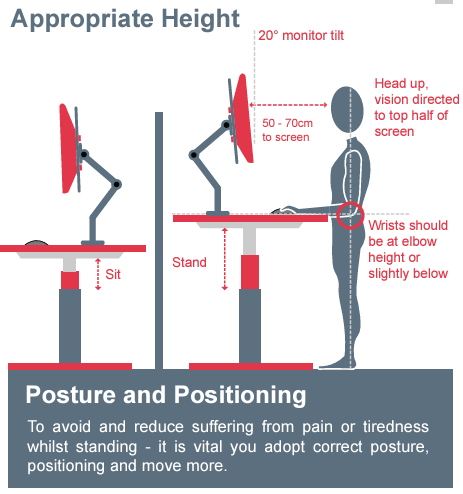What Height Should My Standing Desk Be?
Explore the importance of proper desk height and discover tips to find the right height for your standing desk in our helpful guide.
Proper desk height is more than just a matter of convenience; it's a crucial aspect of creating a workspace that supports your overall health and well-being. Whether you're sitting or standing at your sit-stand desk, the alignment of your body plays a significant role in preventing discomfort, fatigue, and musculoskeletal issues.
In this guide, we'll help you find the perfect height for your standing desk to maximise ergonomic comfort and productivity. Discover how proper desk height impacts your overall health and well-being, and learn key considerations for setting up your workspace. Let's get started!
How Do I Find the Right Height for My Standing Desk?
Determining the optimal height for your standing desk depends on various factors, including your height, posture, and comfort preferences. Here are some quick guidelines to help you find the right desk height for your needs:
Elbow position: A common method for determining standing desk height is to adjust it so that your elbows are bent at a 90-degree angle when typing or using your keyboard. This position ensures that your wrists are aligned with your elbows or slightly below, promoting ergonomic wrist positioning and reducing strain.
Monitor position: Your monitor should be positioned at eye level or slightly below to maintain a neutral neck position and minimise neck strain. Adjust the height of your standing desk accordingly to achieve this optimal monitor position.
Posture and comfort: Stand tall with your shoulders relaxed and spine neutral when using your standing desk. Experiment with different desk heights until you find a position that feels comfortable and allows you to maintain proper posture throughout the day.
For Example:
If you're 5 feet 6 inches tall and prefer to have your elbows at a 90-degree angle when typing, your standing desk height may be approximately 39 to 42 inches.
For someone taller, such as 6 feet tall, the optimal desk height may be slightly higher, around 42 to 45 inches, to accommodate their height and maintain ergonomic wrist and monitor positioning.
Alternatively, if you primarily use your standing desk for tasks that involve reading or viewing documents on your monitor, you may prefer a lower desk height that positions the monitor at eye level or slightly below for optimal viewing comfort.
Remember to adjust your desk height based on your individual preferences and ergonomic needs to create a comfortable and productive workspace.
Tips to Position Your Monitor
Ideal screen distance of 50-70cm: Positioning your monitor at a distance of 50 to 70 centimetres from your eyes is recommended for optimal eye health. This distance minimises eye strain, fatigue, and discomfort, ensuring a comfortable viewing experience and reducing the risk of long-term vision-related problems.
Head and vision positioning: Maintain your head in an upright position and direct your vision to the top half of the screen. By doing so, you encourage better posture and reduce the likelihood of neck and shoulder discomfort associated with prolonged screen use. Additionally, this positioning helps prevent eye strain and promotes overall comfort and productivity throughout the workday.
Tilt your monitor at 20 degrees: To achieve ergonomic viewing, it's recommended to tilt your monitor at approximately 20 degrees. This tilt helps alleviate neck strain and encourages a more natural posture while working, promoting comfort and reducing the risk of musculoskeletal issues.
Learn More About How to Use a Standing DeskTips for Wrist Alignment and Elbow Positioning
Maintaining proper wrist alignment is essential for ergonomic comfort and preventing strain during prolonged periods of work at a standing desk. Ensure that your wrists are positioned at or slightly below elbow height to achieve a neutral wrist posture. This alignment helps alleviate tension and reduces the risk of discomfort or injury.
Incorrect wrist positioning, such as typing with wrists too high or too low, can lead to discomfort, fatigue, and potential repetitive strain injuries (RSIs) like carpal tunnel syndrome. Proper alignment is crucial for reducing the strain on your wrists and promoting long-term comfort and health in the workplace.
To achieve optimal wrist alignment, adjust your desk height accordingly. Experiment with different heights until you find a position that allows your elbows to rest comfortably at a 90-degree angle while typing, with your wrists in a neutral position.
Learn How to Switch to a Standing DeskTips for Posture and Avoiding Fatigue
When using a sit-stand desk, it's essential to maintain good posture to avoid pain and fatigue. Stand tall with your shoulders relaxed, spine neutral, and feet flat on the floor. Keep your head up, eyes focused on the screen's top half, and wrists aligned with your elbows or slightly below.
In addition to maintaining proper posture, taking regular movement breaks throughout the day can help prevent pain and fatigue. Set reminders to stretch, walk around, or perform simple exercises to keep your muscles active and blood flowing. These short breaks can refresh your body and mind, improving productivity and overall well-being.
Another effective strategy for reducing pain and fatigue while standing at your desk is to use an anti-fatigue mat. These mats are specifically designed to provide cushioning and support, which can help alleviate pressure on your feet, legs, and lower back. By standing on an anti-fatigue mat, you can minimise discomfort and fatigue, allowing you to stand for longer periods with greater ease.
Learn More About the Benefits of StandingHeight-Adjustable Standing Desks from Yo-Yo DESK®
Proper desk height plays a crucial role in preventing pain and fatigue while using a standing desk. Apply the guidelines provided in this article to adjust your sit-stand desk height effectively. By aligning your monitor, wrists, and body correctly, you can reduce strain on your muscles and joints, minimise the risk of discomfort and fatigue, and create a workspace that supports your well-being and enhances your productivity.
Ready to upgrade your workspace with Yo-Yo DESK®? Browse our range of adjustable-height standing desks designed to promote health and productivity, and find the perfect solution for you.










